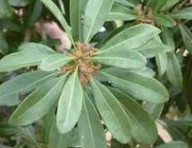Effects of Different Treatments on the Extraction Rate and Composition of Essential Oil of Bayberry Leaves
Abstract: The effects of fresh, dry-drying, microwave drying equipment, blast drying and vacuum freeze-drying on the yield and composition of the essential oils of Chinese bayberry leaves were compared and analyzed. The essential oil of Chinese bayberry leaves was extracted by steam distillation, and the components of the obtained essential oils were separated and identified by GC-MS.

The results showed that different treatment methods had a great influence on the yield and composition of essential oil of bayberry leaf. The yield of essential oil was fresh leaf < microwave drying < natural dry < blast drying < vacuum freeze drying. The essential oils obtained by the five treatment methods identified 33, 43, 42, 39, and 41 compounds, respectively, accounting for 96% of the total. 45%, 96. 1%, 97. 38%, 97. 28%, 68. 03%, both cis-4-cyclopentene-1,3-diol, α-rhedene, ( + ) - 4 -heptenol, transcaryophyllene, epoxidized hopene II, Dianthus Mainly based.
Key words: bayberry leaf microwave drying; essential oil; GC-MS; steam distillation

The arborvitae is also called "Yuyao Yangmei", the origin of which is Yuyao, Zhejiang, belonging to the arbor plants of the genus Arbutus. It is named after the fruit is ripe when the color is purple and black. Its fruit is characterized by roundness and fullness, delicious taste, wide adaptability and high yield. It has been promoted to other provinces in the south, and it has been called “Science and Technology Yangmei” in Guizhou. It is called “hybrid Yangmei” in Jiangxi; in Yunnan Also known as "Big Tree Yangmei."
The fruit of Yangmei has the effect of thirst and digestive, and its roots, stems and leaves are widely used in folk medicine for the treatment of dysentery, diarrhea, rectal bleeding, rheumatic pain, stomach pain and cardiovascular diseases.
The fruit, leaves and bark of the bayberry can be used as medicine and have high economic value. Ancient medical secretary contains Yangmei leaf bitter, slightly pungent, warm, can be used to treat diarrhea, yellow gallbladder hepatitis, lymphatic tuberculosis, chronic pharyngitis and other diseases. Zhejiang Province is a large province of bayberry cultivation. As a renewable resource that can grow rapidly, bayberry leaves are rich in resources.
At the same time, in order to adjust the relationship between growth and fruiting, and promote the persistence, high quality and high yield of Chinese bayberry, the annual adjustment of Yangmei tree needs to be carried out, thus producing a large number of discarded branches of bayberry, and the essential oil of bayberry leaves also has great research value, Yangmei Leaf essential oil not only has antibacterial and anti-inflammatory effects, but also has anti-oxidation and anti-tumor activities. The development and utilization of the resources of the bayberry leaf not only solves the environmental pollution problem brought about by waste treatment, but also increases the industrial value of the bayberry.
In this paper, five different methods of fresh, dry, microwave drying, blast drying and vacuum freeze-drying were used to dry the leaves of Chinese bayberry, and the essential oil of bayberry leaves was extracted by steam distillation and separated and identified by GC-MS. The composition of the obtained essential oils was analyzed for the effects of different drying treatment methods on the yield and composition of the essential oil of bayberry leaves. The research results will provide technical support for the comprehensive development and utilization of Yangmeiye resources.